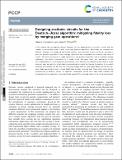| dc.contributor.author | Castellanos, Maria A | |
| dc.contributor.author | Willard, Adam P | |
| dc.date.accessioned | 2021-10-27T19:51:48Z | |
| dc.date.available | 2021-10-27T19:51:48Z | |
| dc.date.issued | 2021-07-21 | |
| dc.identifier.uri | https://hdl.handle.net/1721.1/133255 | |
| dc.description.abstract | <p>Precisely arranged sets of dye molecules can utilized as elementary quantum computing elements. Here, we consider two different strategies for designing these excitonic circuits for a 2-qubit multi-step quantum algorithm.</p> | en_US |
| dc.language.iso | en | |
| dc.publisher | Royal Society of Chemistry (RSC) | en_US |
| dc.relation.isversionof | 10.1039/d1cp01643a | en_US |
| dc.rights | Creative Commons Attribution 3.0 unported license | en_US |
| dc.rights.uri | https://creativecommons.org/licenses/by/3.0/ | en_US |
| dc.source | Royal Society of Chemistry (RSC) | en_US |
| dc.title | Designing excitonic circuits for the Deutsch–Jozsa algorithm: mitigating fidelity loss by merging gate operations | en_US |
| dc.type | Article | en_US |
| dc.contributor.department | Massachusetts Institute of Technology. Department of Chemistry | |
| dc.relation.journal | Physical Chemistry Chemical Physics | en_US |
| dc.eprint.version | Final published version | en_US |
| dc.type.uri | http://purl.org/eprint/type/JournalArticle | en_US |
| eprint.status | http://purl.org/eprint/status/PeerReviewed | en_US |
| dc.date.updated | 2021-08-13T17:06:05Z | |
| dspace.orderedauthors | Castellanos, MA; Willard, AP | en_US |
| dspace.date.submission | 2021-08-13T17:06:06Z | |
| mit.journal.volume | 23 | en_US |
| mit.journal.issue | 28 | en_US |
| mit.license | PUBLISHER_CC | |
| mit.metadata.status | Authority Work and Publication Information Needed | |
